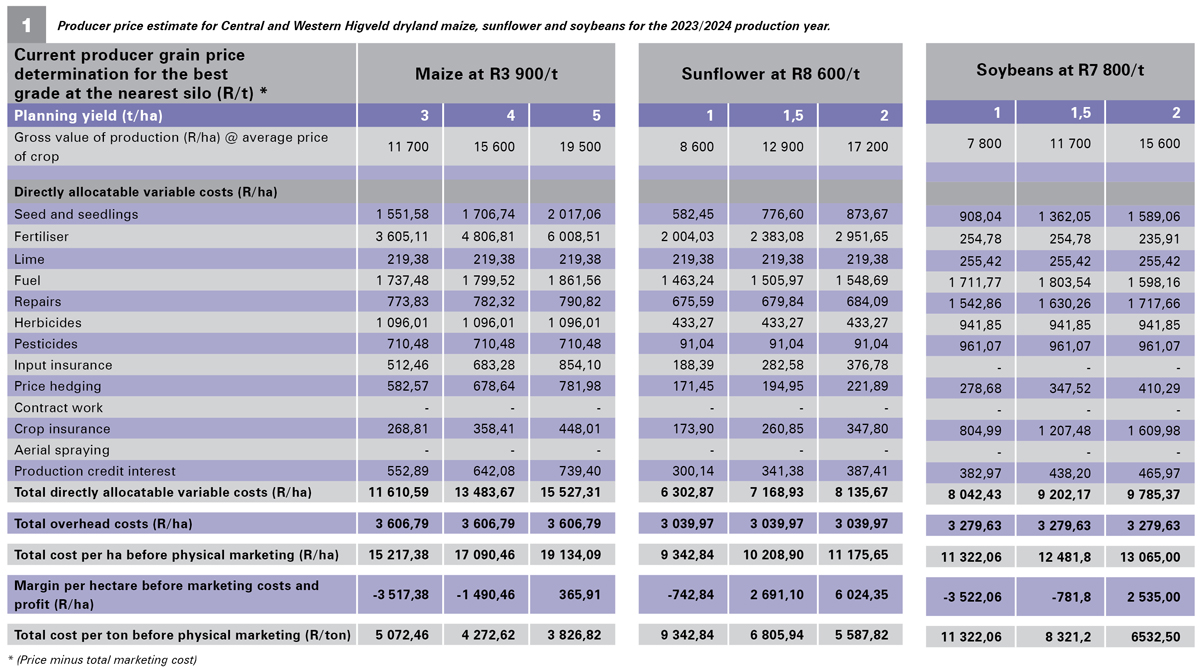August 2023
| CHRISTIAAN VERCUIEL, AGRICULTURAL ECONOMIST, GRAIN SA AND PIETMAN BOTHA, INDEPENDENT AGRICULTURAL CONSULTANT |
 |
A farm must be seen as a business and run accordingly. Farming is not only about the physical work being done to produce the crop, but must also make a profit. Strict management rules must be established, implemented and followed to ensure that farmers can produce profitably and sustainably.
In the January 2023 issue of Pula, the article ‘Plan ahead for the planting season’ was published. In this article, detailed information was provided to compile your own production cost. In the July issue of Pula, the article ‘Prevent unplanned financial surprises’ appeared, where the fixed cost dilemma was discussed in detail.
Planting is a time-sensitive game and choosing the correct planting timeframe can be tricky. So, when is it practical to plant? To answer this question, you must look at input costs and income.
INPUT COSTS
Farming input costs are all the costs incurred to produce a crop. To make it more applicable to agriculture, input costs are defined as all the costs related to the production and harvesting of crops such as fuel, fertiliser and agricultural chemicals.
Input costs can be divided into two different categories, namely:
In short, total cost = variable cost + fixed cost. In farming terms, the total cost to produce the crop is equal to the overhead expenses such as rent, upkeep, electricity line hire, levies and taxes, plus expenses such as the cost of seed, fertiliser, fuel and agricultural chemicals.
INCOME
Income is the amount of money or property received for goods sold or services delivered.
Gross income for agriculture is the total amount of money that a farmer receives for the product that he produces and delivers. In practical maize terms, it means the Safex price less transport differential less the costs at the silo – in other words, the net farmgate price times the yield is your gross income.
Net income can also be referred to as profit. It is the income after all expenses have been subtracted. Expenses include all expenses incurred such as taxes, fuel, levies, fertiliser and subtractions.
Net income = gross income minus expenses.
WHEN IS IT NOT VIABLE TO PLANT?
The goal of any farmer should be to produce products in such a way that he can cover the cost of his crop and living expenses – and have enough left to either plant the crop cash, or to serve as an asset which helps him to get a loan.
Farmers should therefore use the following equation to test the viability of planting:
Profit/loss = income minus expenses
In farming terms, this means that the net income (profit) is equal to the money a farmer receives from selling his product minus the cost of production.
It is very important for farmers to do their homework properly before they commit to planting a crop. This means that the farmer must be accurate in his prediction of costs and income, as an inaccurate prediction of these concepts can lead to inefficiency and loss.
COST FOR THE 2023/2024 SEASON
How much is it going to cost to plant a hectare in the 2023/2024 production year?
Central and Western Highveld production regions
In Table 1, the cost for maize, sunflower and soybeans for the Central and Western Highveld production regions is shown for the different yields. These costs are an example – it can differ drastically from this calculation. The prices for fertiliser, herbicide, pesticide and fuel can still change before planting. Every farmer must compile his own budget and then decide accordingly.

Eastern Highveld production regions
In Table 2, the Eastern Highveld production region's cost for maize and soybeans at different yields is shown. These costs as mentioned are an example and can also differ drastically from this calculation. Every farmer must compile his own budget and then decide accordingly.

Publication: August 2023
Section: Pula/Imvula